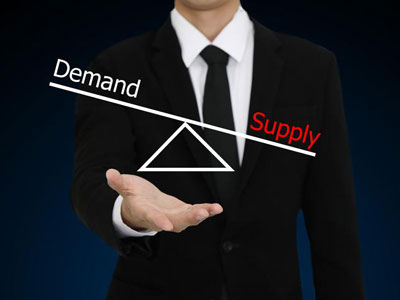Demand is soaring but supply is scarce. There is no doubt that we have a serious issue of limited supply. The pandemic created volatility in both demand and supply, causing a significant overload of ships at the L.A. and Long Beach ports early this year as Chinese factories caught up with production, e-commerce demand skyrocketed, and longshoremen were out due to COVID. And that was just one incident.
At first, they hoped they’d catch up by the summer, but it appears as though we are simply in a new normal. Of course, it created a ripple effect with bulging warehouses in Inland Southern California, lack of warehouse space and rising logistics costs throughout the area. Ocean freight and transportation costs are also soaring. If you aren’t a customer of choice, you are likely at the back of the line and paying high prices.
Shortages abound, starting with semiconductor chips. There isn’t enough foundry capacity, yet demand is booming with cloud infrastructure providers as well as smartphone makers during the pandemic while automotive is ramping back up. When automotive cancelled orders during the pandemic, suppliers found other customers. The issue is significant, and so there is a rush to open new foundries. Intel is spending $20 billion to build two foundries in Arizona, TSMC is building new foundries in Taiwan, and Samsung is also building foundries. In the interim, there are extended lead times and shortages.
Next, the freeze in Texas caused significant delays and shortages in oil and gas related products as well as surging demand in building products which were already high as people made home improvements while at home during the lockdown. For example, the price of lumber is ridiculous, and prices have gone up 375% since a year ago. Clients supplying the building and construction products industries are having a very hard time keeping up with customer demand, and their suppliers’ lead times are extending 3 and 4-fold. One of the industries most impacted by the Texas storm was automotive. It caused temporary closures of semiconductor chip production, creating further shortages of chips.
If that wasn’t enough, a ship got stuck in the Suez Canal causing all sorts of delays and complications on another major shipping route. The ship blocked a major waterway accounting for 12% of global trade (preventing 50 ships a day from passing) for about a week. It reverberated throughout the supply chain with congestion at ports, ships not where they were supposed to be when they were supposed to be there and ships being rerouted on longer routes. The impacts will last months.
On a final note, there are extensive shortages of people throughout the supply chain. Companies cannot find people to fill key roles. Some people are retiring; others are leaving for better opportunities; yet others are changing careers as the pandemic caused many to rethink their career and life. In addition to a shortage of materials, there is a shortage of people to manufacture, process, transport, distribute and respond to changing customer needs.
Why SIOP Matters
SIOP (Sales, Inventory and Operations Planning) helps to better forecast demand including partnering with customers to gain a clearer and more timely view into end customer demand to align with supply. Simply gaining a better view into demand by key customers and/or core product lines can give you the 80/20 required to determine a directional view of manufacturing capacity, long lead-time materials / supply items and information for offload / insource decisions. We have seen a dramatic increase in interest for SIOP programs to create predictability and flexibility while reducing risk.
SIOP aligns demand and supply to enable growth with increased customer service, profitability and accelerated cash flow. Refer to our blog for many articles on SIOP. Also, read more about these types of strategies in our eBook, SIOP (Sales Inventory Operations Planning): Creating Predictable Revenue and EBTIDA Growth. If you are interested in talking about what it would take to purse the SIOP journey in your business, contact us.
Did you like this article? Continue reading on this topic:
Sales Forecasts are Rising Fast. Do You Have Capacity?



